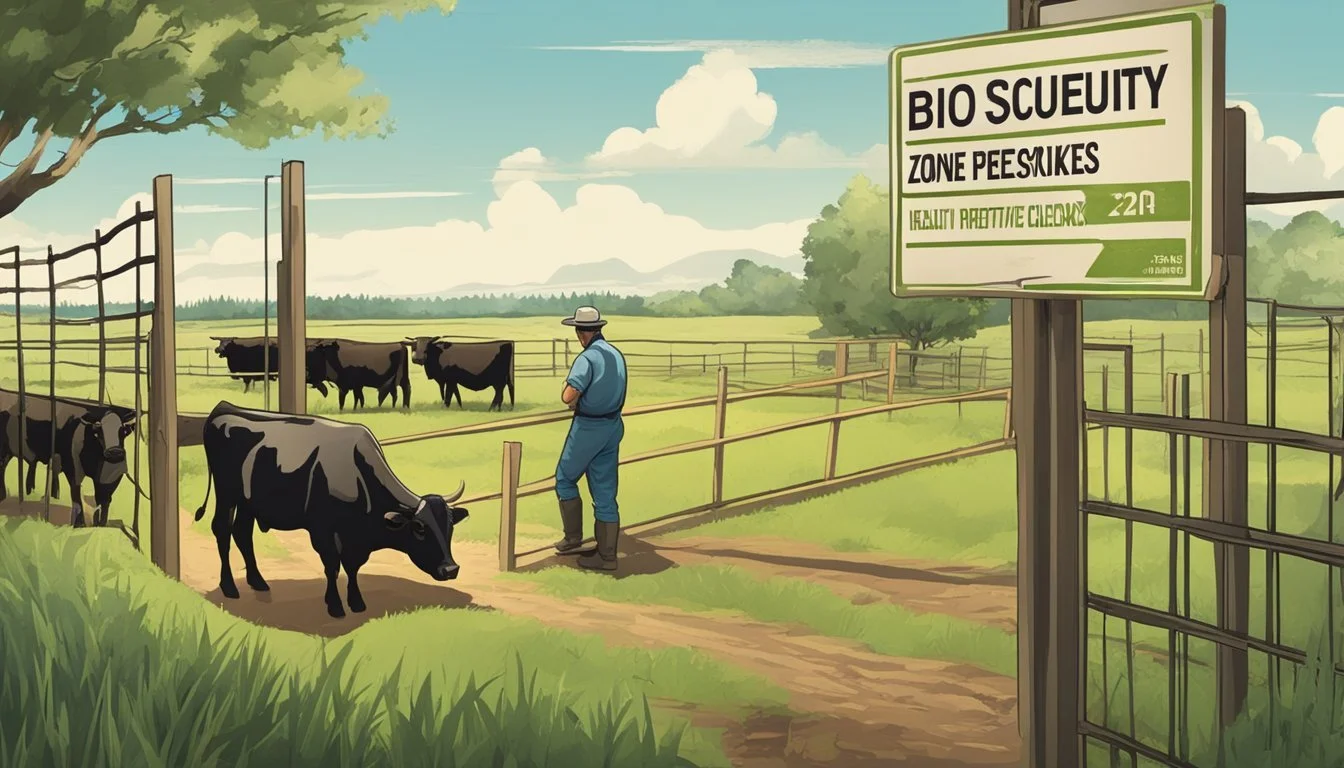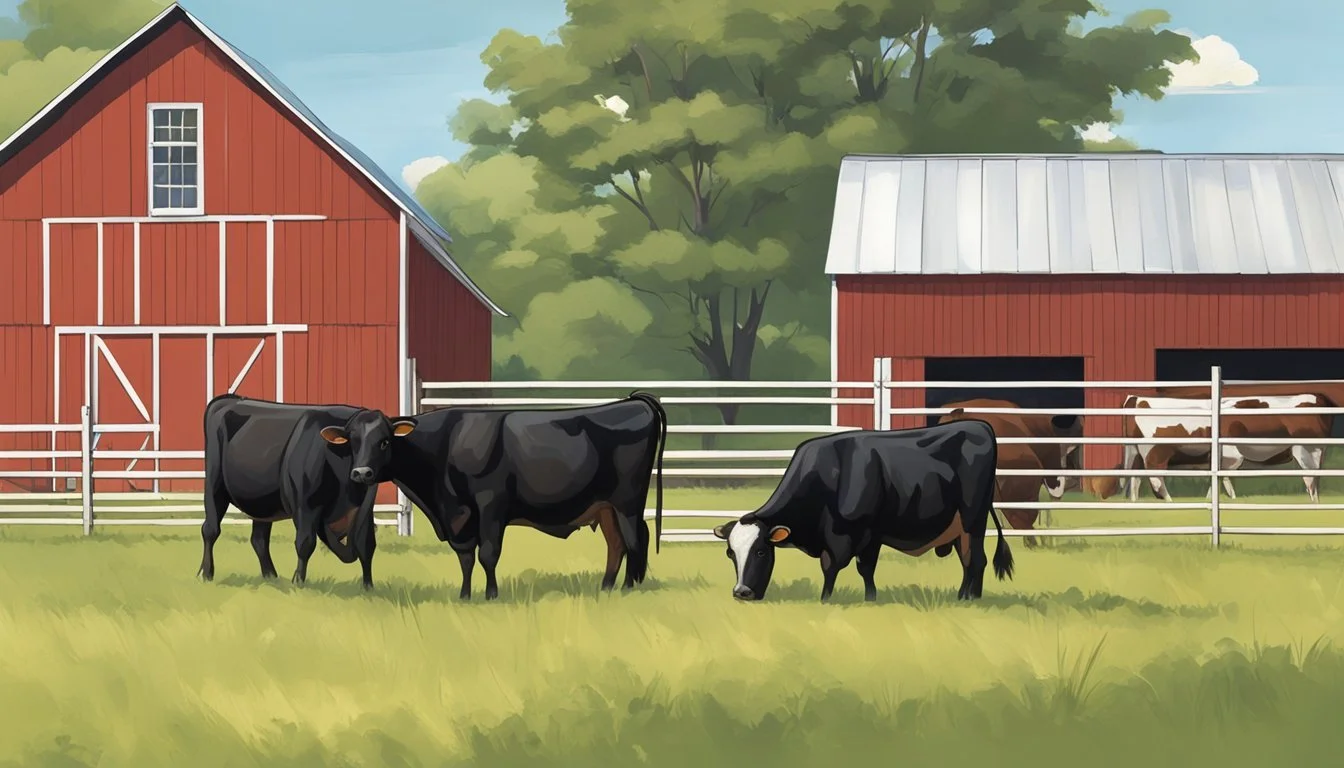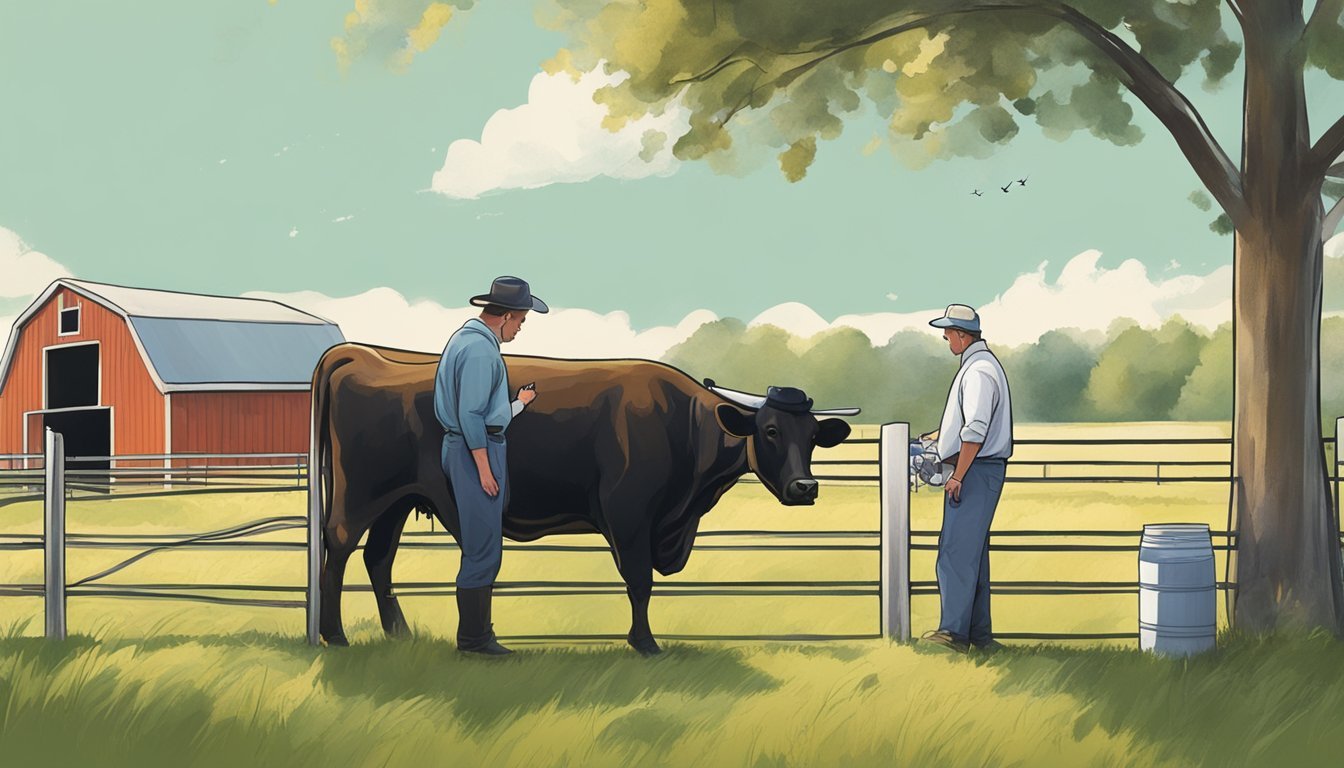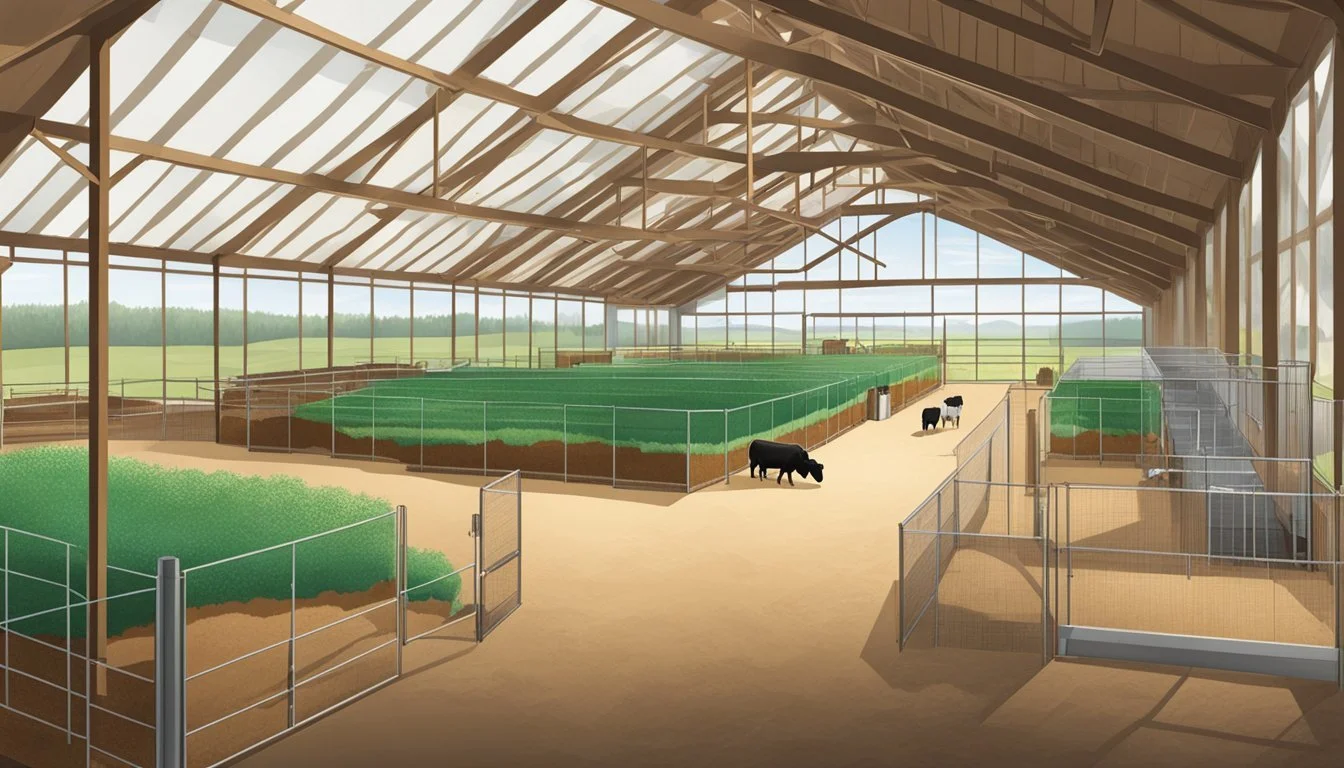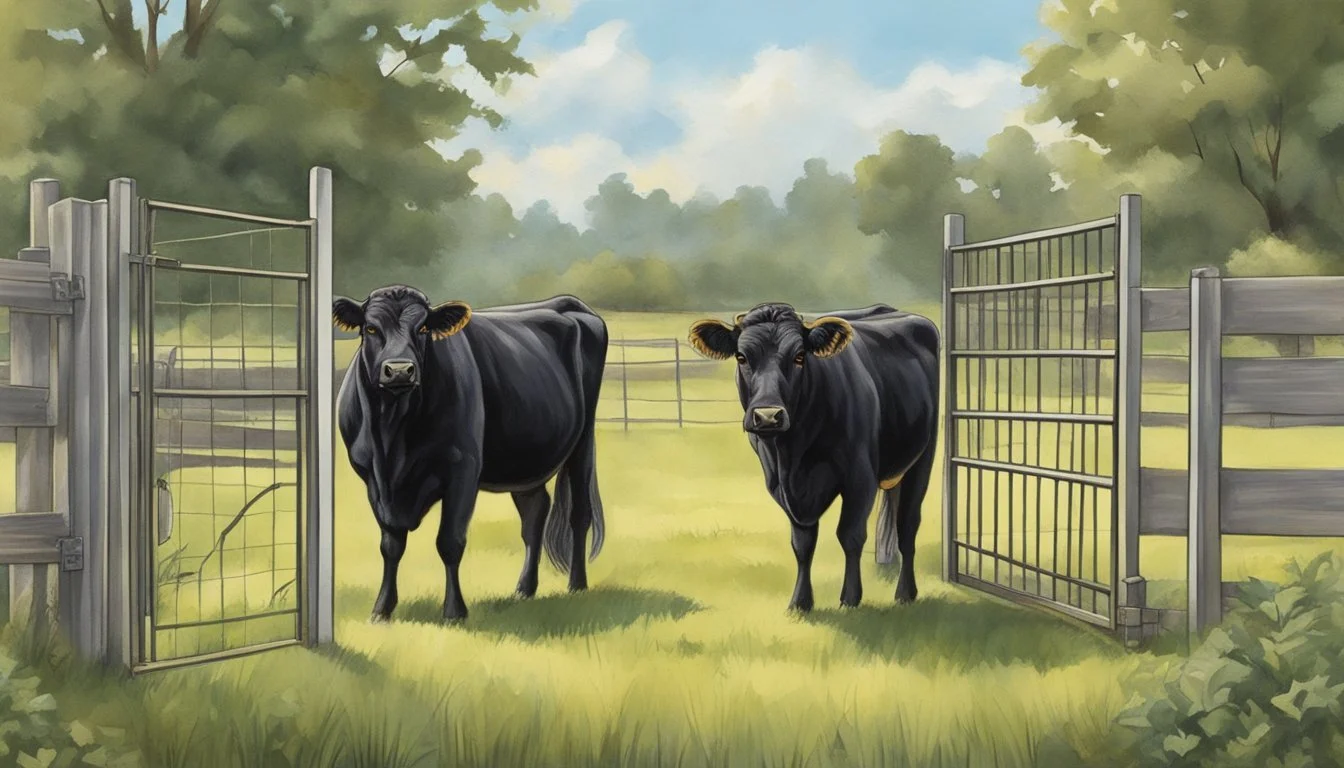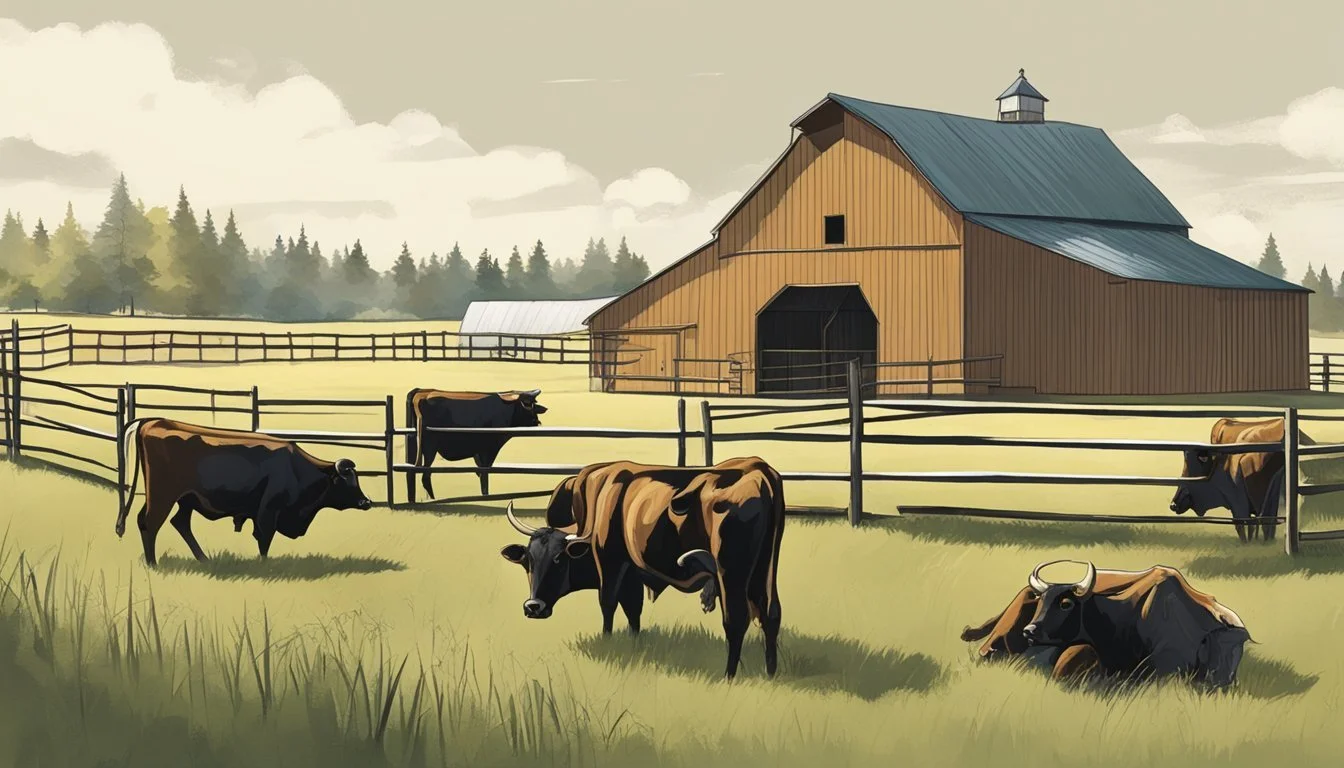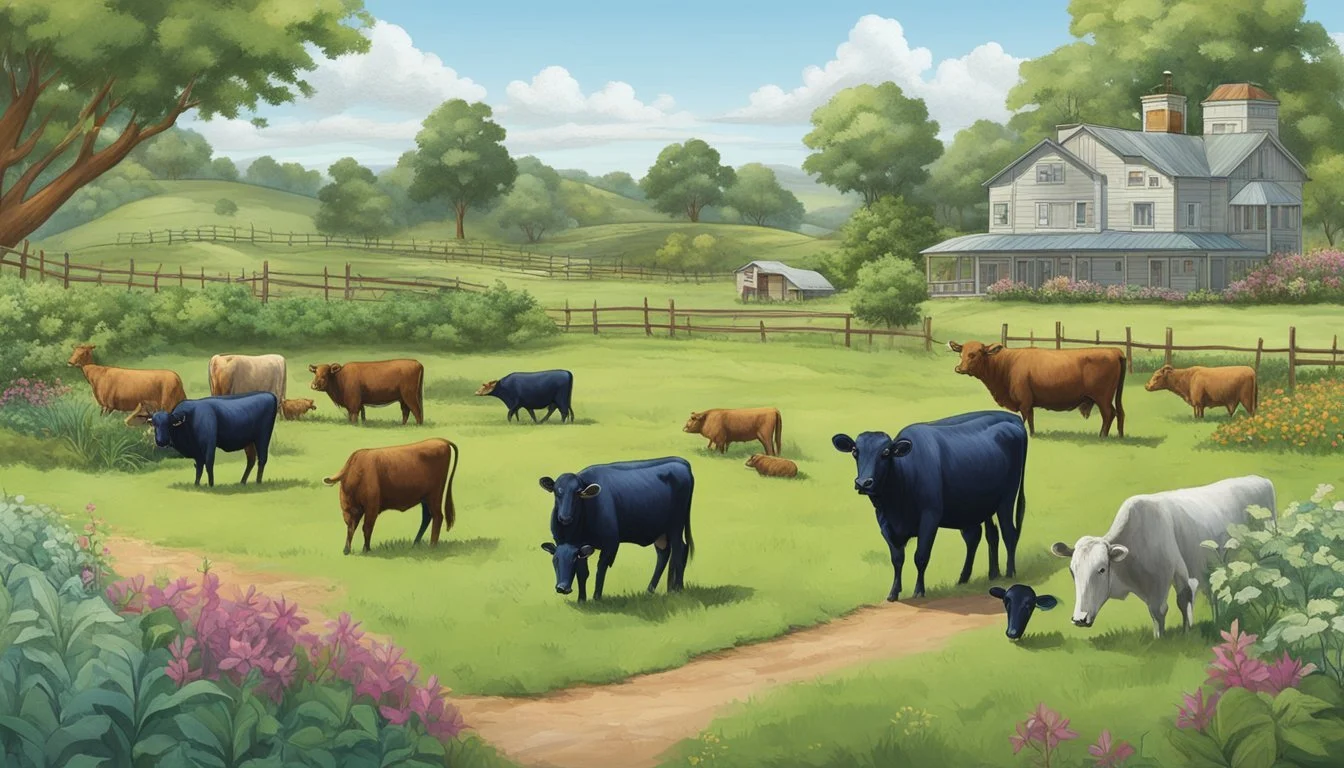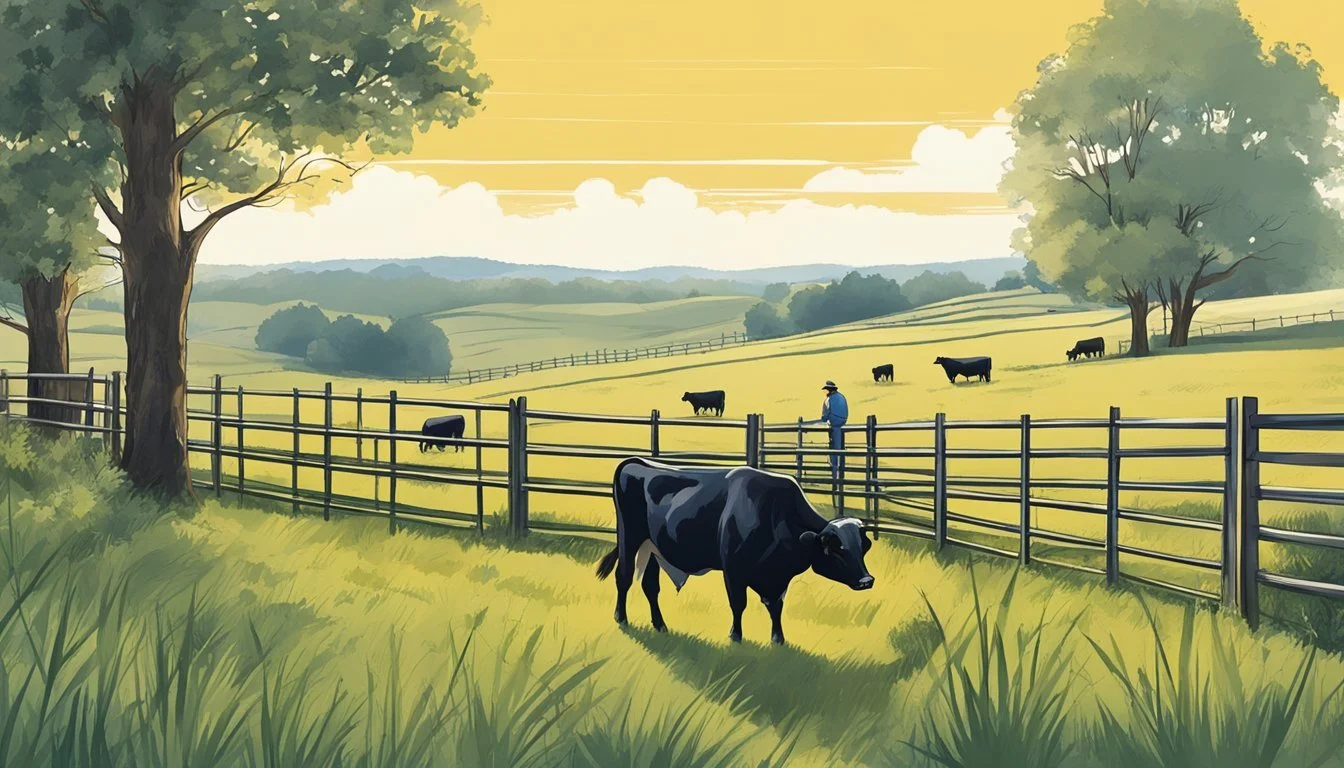Dexter Cattle and the Importance of Biosecurity
Protecting Your Homestead's Health
Dexter cattle are a small, hardy breed often associated with sustainable farming and homesteading due to their dual-purpose capabilities for both milk and meat production. Originating from Ireland, these mini cows excel in diverse climates and are praised for their efficient meat conversion rate, which surpasses other breeds such as the Jersey, with Dexters yielding more than 60% meat. Their adaptability and smaller stature make them an appealing choice for those operating on limited space and resources, aligning well with the ethos of homestead living where self-sufficiency is key.
Maintaining a healthy homestead requires robust biosecurity measures to protect livestock from disease and contamination. Biosecurity encompasses a range of practices designed to prevent the introduction and spread of infectious agents. For homesteaders raising Dexter cattle, biosecurity is paramount; it includes strategies such as controlling farm access, managing animal movement, and ensuring feed and water sources are uncontaminated. The establishment of preventative measures safeguards not only the health of the Dexters but also underpins the overall productivity and resilience of the homestead.
Implementing strict biosecurity protocols is essential for livestock well-being and the sustainability of homestead operations. This is especially critical in the context of Dexter cattle, as their compact size and resourcefulness are crucial for the cramped confines of smaller farms. A robust biosecurity plan contributes significantly to the long-term success of homesteading efforts, ensuring that these miniature breeds continue to thrive and fulfill their role as a core pillar in the realm of self-reliant farming.
History and Origin of Dexter Cattle
Dexter cattle trace their lineage back to Ireland in the 18th century. Originally from County Kerry, these cattle are believed to be named after a man known as Mr. Dexter, an agent on the estates of Lord Hawarden on Valentia Island. They were considered a smaller type of Kerry cattle and were esteemed for their dual-purpose capabilities, providing both milk and meat.
The breed's expansion to America began in earnest in the early 20th century. The American Kerry and Dexter Club, established in 1911, played a significant role in promoting Dexter cattle. By 1924, the English Kerry and Dexter Cattle Society had evolved to focus solely on Dexter cattle, leading to the formation of the Dexter Cattle Society. The society's records indicate a substantial growth in recorded animals by 1926, with numbers reflecting 986 bulls and 3,896 cows since the foundation of the English herd book in 1892.
In America, interest continued, and after a period of dormancy, the American Kerry and Dexter Club was resurrected in 1940. Eventually, in 1957, the organization adopted the name it goes by today: the American Dexter Cattle Association. Despite a period where the breed neared extinction in the United States by the mid-1970s, renewed importation and interest in British Dexters helped to stabilize their presence.
Key points in Dexter Cattle history in America include:
1911: American Kerry and Dexter Club establishment
1940s-1970s: Fluctuation in populations; near extinction
1957: Formation of the American Dexter Cattle Association
Characteristics of Dexter Cattle
Dexter Cattle boast a distinct set of attributes in both their physical appearance and behavior which have been honed through years of selective breeding. They are known for their compact size and amiable nature, making them a favored breed for small-scale farming.
Physical Traits
Size: Dexters are the smallest European cattle breed. They are considered a miniature breed, which contributes to their popularity among small homesteads.
Weight: The average weight for Dexter bulls is approximately 1,000 pounds, while cows typically weigh around 750 pounds.
Color: Their coats come in three primary colors:
Black: The most common color for Dexter Cattle.
Red: A less common but recognized color in the breed.
Dun: A pale brown shade also found in the breed.
These cattle are primarily solid colors without extensive markings.
Traditionally, Dexters were horned, but there has been a shift with many now being naturally polled (without horns) due to selective breeding.
Behavior and Temperament
Docile Temperament: They are generally known for their docile and calm demeanor, which contributes to their manageability.
Hardiness: Dexter Cattle have garnered a reputation for their robustness, allowing them to thrive in various environmental conditions. They are adaptable and can maintain their health with minimal supplementary feed.
Through maintaining a moderate size and weight, coat colors that range from black to red and dun, and a desirable temperament, Dexter Cattle continue to serve as a versatile and efficient option for both milk and beef production on homesteads seeking to implement biosecurity and manage livestock successfully.
Dexter Cattle as Dual-Purpose Livestock
Dexter cattle are a versatile breed, well-suited for both meat and milk production, making them an ideal choice for homesteads focused on diverse yield. Small in stature, they nonetheless offer significant output relative to their size.
Beef Production
Dexter cattle are renowned for their quality beef. Their compact frames are deceptive; they can provide an average of 400 pounds of meat. These animals efficiently convert feed into meat, which ensures a sustainable and profitable beef production cycle. Their meat is known for its tender texture and excellent flavor profile, which stands out in the market.
Milk Production
Aside from beef, Dexters are prized for their dairy potential. They produce rich milk, with a higher butterfat content than many larger dairy breeds. While they may yield less milk volume-wise compared to specialized dairy breeds, the quality of their milk — dense in nutrients and ideal for cheese production — makes them a valuable asset for small-scale milk production.
Biosecurity on the Homestead
Biosecurity encompasses strategies and management practices crucial for protecting homestead livestock, such as Dexter Cattle, from infectious diseases.
Importance of Biosecurity
Biosecurity is vital on a homestead to prevent the introduction and spread of infectious diseases among livestock. Dexter Cattle, like all other livestock, are susceptible to various pathogens that can compromise their health and the safety of food products. Effective biosecurity practices safeguard the health of animals and the economic stability of the homestead.
Prevention: Keeping diseases off the homestead is more cost-effective than treating an outbreak.
Containment: If a disease enters the homestead, proper measures can restrict it from spreading.
Public Health: Protection against zoonotic diseases enhances public safety and food security.
Implementing Biosecurity Measures
Homesteaders must adopt a set of biosecurity practices to minimize the risk of infectious diseases. A robust biosecurity protocol includes:
Isolation and Quarantine
Isolation of New Arrivals: New or returning animals should be kept separate from the herd for a minimum of 30 days.
Quarantine Areas: Designated areas for sick animals help prevent contact with the healthy herd.
Management Practices
Sanitation: Regular cleaning and disinfection of equipment and facilities.
Controlled Access: Limitation of farm access only to essential personnel and controlled visitor entries.
Disease Management
Monitoring: Continuous observation of animal health for early disease detection.
Treatment Protocols: Established veterinary-approved procedures for the treatment of sick animals.
By implementing such measures, homesteaders can create a barrier against infectious agents, ensuring the welfare of their Dexter Cattle and the overall productivity of their homestead.
Feeding and Nutrition
Proper nutrition is crucial for the health and productivity of Dexter cattle. Tailoring the feed to meet their specific dietary needs can ensure that these cattle thrive on a homestead.
Feeding Dexter Cattle
Dexter cattle, a hardy and adaptable breed, can generally maintain good body condition on a diet that is less intensive than that required by larger breeds. They are known to efficiently convert feed into meat and milk, which can result in lower feed costs for the homesteader. Dexters primarily consume forage and can graze on a variety of grasses and legumes. They require ample access to clean water and adequate forage to fulfill their dietary needs.
When forage quality is low or during periods when pastures are not available, they may need supplementary feed. It is important to gradually introduce any supplemental feed, such as hay or grain, to prevent digestive upsets. Overfeeding grain can lead to obesity and other health issues in Dexter cattle, so managing quantities is as important as managing the type of feed given.
Nutritional Requirements
The nutritional needs of Dexter cattle vary according to age, weight, and production status (e.g., gestation, lactation). They require a balanced diet containing appropriate levels of energy, protein, vitamins, and minerals.
Protein: A crucial component, especially in growing and lactating animals, can be provided through pasture and legumes or supplemented with soybean meal or other protein-rich feeds.
Energy: Often sourced from pasture and hay. When additional energy is needed, grains such as corn or barley can be used, but should not exceed recommended daily allowances to prevent health issues.
Vitamins and Minerals: Vital for the prevention of deficiency problems. A mineral supplement can be offered free-choice or included within feeds to ensure cattle get the necessary micronutrients.
It is essential to provide a diet that supports the cattle's developmental and physiological stages. Feed testing and working with a livestock nutrition specialist can help to optimize the diet for the specific needs of Dexter cattle on the homestead.
Health and Veterinary Care
Ensuring the health and vitality of Dexter cattle involves a proactive approach to disease prevention and diligent veterinary management. A thorough understanding of common diseases and the establishment of a robust veterinary care routine are imperative for maintaining a healthy herd.
Common Diseases
Dexter cattle, like all animals, are susceptible to specific health problems. Two of the more common diseases include:
Johne's Disease (Mycobacterium avium subspecies paratuberculosis): A contagious bacterial disease affecting the intestines, often resulting in weight loss and diarrhea. It is more commonly observed in older animals but calves can also be at risk.
Bovine Respiratory Disease (BRD): Affects calves and older animals, and could be prompted by environmental stressors. It is characterized by coughing, fever, and difficulty breathing.
Health status monitoring is critical for early disease detection and control.
Veterinary Management
Regular veterinary oversight is essential for maintaining herd health. Key aspects include:
Vaccination Protocols: Implementing a vaccination regimen that covers common bovine diseases is a staple of good herd health management. Vaccinations are critical in both calves and healthy animals as a preventative measure.
Routine Check-ups: A veterinarian should regularly assess the health status of the cattle to detect any potential issues before they become widespread problems. Especially, calves should be monitored closely as they are particularly vulnerable to diseases.
Veterinarians also play a critical role in educating farm owners on biosecurity measures, ensuring they comprehend the significance of quarantine procedures and the appropriate handling of both healthy and ill animals.
Breeding and Calving
Breeding and calving are critical phases in managing Dexter cattle. They demand precise practices to ensure the health and productivity of the herd.
Breeding Practices
Dexter cattle breeders typically observe an average gestation period of 279 to 287 days. It's important to track the breeding timeline accurately as bull calves may have a slightly longer gestation period compared to heifer calves, averaging 1 to 7 days more. Breeding should be managed responsibly to ensure the optimal health of both cows and bulls, keeping in mind the following points:
Estrus Detection: Monitoring the cow's heat cycles for signs of estrus is vital for timely breeding.
Record Keeping: Maintaining accurate records of mating dates aids in predicting calving dates and managing breeding intervals.
Calving and Rearing Calves
The arrival of new calves is a delicate period that requires meticulous care and biosecurity measures to protect the health of the offspring and the entire herd.
Calving Preparation: Farmers should prepare a clean, well-bedded, and sheltered area for cows to calve. This environment reduces the risk of disease transmission.
Colostrum Management: Ensuring calves receive colostrum within the first few hours after birth is crucial for immunity.
Biosecurity: Limiting contact between newborn calves and potential pathogen carriers, whether it be humans or other animals, is key to safeguarding calf health.
By adhering to stringent breeding and calving protocols, Dexter cattle breeders can foster a thriving and disease-free homestead.
Housing and Space Requirements
Proper housing and space management are crucial for the well-being of Dexter cattle, ensuring a healthy and productive herd. These specific requirements protect the cattle from environmental stress and contribute to the biosecurity of the homestead.
Housing Dexter Cattle
Dexter cattle are a hardy breed, requiring less elaborate housing solutions than larger cattle. They typically need a shelter that provides protection from severe weather conditions, including heavy rain, wind, and extreme temperatures. The structure should offer adequate ventilation while preventing drafts, which can cause respiratory issues. Essential features of housing include:
Roofing: To shield from precipitation and harsh sun.
Walls: Three sided, to allow for natural airflow.
Bedding: Absorbent to manage manure and moisture, maintaining hygiene.
Space: Approximately 150 square feet per adult to prevent overcrowding.
Space and Pasture Management
The management of space and pasture plays a pivotal role in maintaining a healthy Dexter cattle herd. They require access to pasture providing both nutritional grazing and enough room to exhibit natural behavior. Key considerations include:
Pasture Area: Ranging from 1 to 2 acres per animal to ensure ample grazing.
Climate Adaptation: Pasture lands must suit local climatic conditions to support forage growth.
Manure Management: Regular removal from housing and pasture to prevent disease.
Fencing: Sufficient to contain the cattle without being overly restrictive, taking into account their smaller stature.
Provision of adequate space is not only important for cattle health but is also crucial in managing biosecurity risks, by minimizing the potential for disease transmission between animals.
Handling and Behavior
Dexter cattle are known for their docile temperament, making them an excellent choice for homestead management. Their manageable size and generally calm demeanor contribute to ease of handling, ensuring daily interactions are pleasant and productive.
Ease of Handling
Dexter cattle typically exhibit a cooperative nature, which greatly facilitates their handling. The breed's characteristics include:
Smaller stature: Their compact build makes them less intimidating and easier to manage than larger breeds.
Gentle temperament: Dexters are often more compliant, simplifying routine tasks such as veterinary check-ups and milking.
Effective handling also hinges on proper facility design. For instance, sturdy fences and well-designed chutes enhance safety for both the animal and the handler.
Training and Daily Interaction
Frequent, consistent interaction forms the bedrock of effective cattle management. Training should focus on:
Establishing routines: Animals thrive on consistency, which cultivates a sense of security and cooperation.
Positive reinforcement: Encouraging desired behavior with rewards reinforces trust between the Dexter and its handler.
Personal knowledge and experience play a critical role in recognizing and interpreting cattle behavior, thus informing appropriate management strategies. Handlers should remain neutral and clear in their actions to avoid confusing the animal. Regular, attentive engagement helps homesteaders understand individual nuances in behavior, ensuring a harmonious environment.
Economic Considerations
When evaluating the economic viability of raising Dexter cattle, prospective and current homesteaders must consider both the costs and potential revenue streams. These financial considerations are critical to ensuring a sustainable operation.
Cost Analysis
An essential aspect of maintaining a homestead with Dexter cattle is understanding the associated costs. These costs can be categorized and analyzed to ensure the farm's economic efficiency. Below is a breakdown of typical costs associated with raising Dexter cattle:
Initial Investment:
Purchase of cattle
Fencing and housing infrastructure
Ongoing Expenses:
Feed and nutritional supplements
Veterinary care and biosecurity measures
Labor for daily operations
Biosecurity Costs:
Implementation of preventive measures
Regular health screenings and vaccinations
Revenue from Dexter Cattle
Dexter cattle provide multiple streams of revenue for a homestead, which include both dairy products and beef production. Their versatility is a boon for farmers looking to diversify.
Dairy Production:
Sale of milk and artisanal cheese
Beef Production:
Sale of meat from culled animals and offspring
Farmers who invest in biosecurity can see improved herd health, leading to higher productivity and, subsequently, better economic outcomes. Moreover, efficient biosecurity practices can lower long-term costs by preventing disease outbreaks that can be costly to manage and eradicate.
Environmental Impact and Sustainability
Biosecurity on homesteads hosting Dexter cattle directly influences environmental integrity and the sustainability of agricultural practices. Optimal biosecurity measures can mitigate environmental contamination and bolster sustainable cattle rearing.
Environmental Considerations
Dexter cattle, like any livestock, can impact their surrounding environment. Manure management is critical, as mishandling can lead to nitrogen and phosphorus contamination of water sources. Homesteads need to implement a comprehensive waste disposal system to prevent runoff that can carry pathogens and nutrients into waterways.
Furthermore, proper feed management reduces waste and the chance of feed contamination entering natural ecosystems. This is vital for maintaining the health of local flora and fauna, which compete with cattle for resources and space. Implementing rotational grazing practices can minimize soil compaction and overgrazing, thus preserving plant diversity and soil health.
Sustainable Practices
Sustainable agriculture practices must be in place to ensure the longevity and health of the homestead ecosystem. Dexter cattle owners are encouraged to observe the following:
Rotational Grazing: Helps improve soil fertility and health, and promotes regrowth of pastures.
Integrated Pest Management (IPM): Utilizes biological controls and selective chemical application, reducing environmental chemical load.
Renewable Energy Solutions: Including solar-powered electric fencing and water systems, reducing greenhouse gas emissions.
Conservation of resources, such as water and feed, is not only cost-effective but also reduces the ecological footprint of cattle farming. Water-saving devices and accurate feed measurements ensure that resources are used responsibly.
By adhering to these considerations and practices, Dexter cattle homesteads can maintain a balance between productive agriculture and environmental stewardship.
Community and Education
The Dexter cattle breeders' dedication to biosecurity measures on their homesteads plays a crucial role in the broader livestock community. It is essential for homesteaders to both gain and impart knowledge concerning biosecurity to ensure the well-being of their herds and, by extension, the community at large. Active participation in educational initiatives and effective communication among stakeholders are central to this effort.
Sharing Knowledge with the Community
Homesteaders have a responsibility to share their experiences and best practices for managing Dexter cattle, especially biosecurity protocols, with their local community. Local workshops and community meetings are effective platforms for disseminating information. Here the homesteaders can highlight the importance of biosecurity practices such as:
Quarantining new animals
Managing visitor access to livestock areas
Regular veterinary checkups
These interactions foster a culture of transparency and mutual learning, greatly benefiting community health.
Learning from Experts
Education does not end with the knowledge already possessed; it is a continuous process. Homesteaders must seek out and participate in ongoing education provided by:
Expert Sources: Extension Services, Type of Training: Workshops and publications
Expert Sources: Veterinary Associations, Type of Training: Latest research insights
Expert Sources: Academic Institutions, Type of Training: Up-to-date biosecurity strategies
By engaging with experts, homesteaders stay informed on evolving biosecurity risks and new preventative measures, thereby maintaining cattle health and ensuring the safety of the homestead's ecosystem.
Biosecurity Protocols for Visitors
Biosecurity is essential in maintaining the health of Dexter cattle on any homestead. Visitors can unintentionally introduce pathogens that can be detrimental to livestock. Therefore, a strict set of biosecurity practices must be enforced.
Before Arrival:
Inform visitors prior to their arrival about the biosecurity measures in place.
Schedule visits to ensure minimal disruption and contact with the animals.
Upon Arrival: Visitors should be provided with the following:
Designated Parking: Vehicles remain in designated areas, away from livestock.
Footwear: Disposable boots or disinfection of shoes before entering.
Protective Clothing: Provide clean gloves and disposable outerwear if necessary.
During the Visit:
Visitors must use hand sanitizing stations before and after interaction with the animals.
Movement around the farm should be kept to a minimum to avoid unnecessary exposure.
Item: Boots and Gloves, Action Required: Disposal or disinfection
Item: Equipment, Action Required: No sharing unless sanitized
Item: Bins and Buckets, Action Required: Designated for visitors only and cleaned post-visit
Item: Vehicles, Action Required: Parked in the designated area, no driving near livestock zones
Strict adherence to these protocols protects both the livestock and the livelihood of the homesteader. Every visitor's compliance contributes to the overall biosecurity of the farm.
Monitoring and Record-Keeping
Effective management of Dexter cattle requires diligent monitoring and precise record-keeping that establish a foundation for biosecurity on the homestead. These practices ensure that health status is constantly evaluated and biosecurity protocols are rigorously followed.
Health Monitoring
Regular health monitoring of Dexter cattle is crucial. A systematic check involves:
Daily Observation: Noting changes in behavior, appetite, and physical condition.
Regular Health Checks: Scheduled examinations by a veterinarian to assess overall health.
These practices provide the necessary knowledge to detect issues early, thus enabling prompt management actions to prevent disease spread.
Biosecurity Record-Keeping
Biosecurity record-keeping is a structured protocol that tracks:
Entry and Exit Logs: A detailed list of all individuals and equipment entering or leaving the property.
Health Records: Documentation of each animal's health status and medical history.
Organized records enhance the homestead's ability to trace and manage health-related events efficiently.

